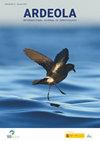Factors Shaping Breeding Phenology in Birds: An Assessment of Two Sympatric Acrocephalus Warblers with Different Life Histories
IF 1.2
4区 生物学
Q2 ORNITHOLOGY
引用次数: 4
Abstract
Summary. Timing of reproduction is a critical life-history trait and implies major fitness consequences. Differences in life history strategies can lead to different responses to the same environmental conditions even among closely related species. Investigating the factors affecting the timing of reproduction in closely related and sympatric species may help understanding the relationship between different life history traits and species-specific responses to ecological factors. We investigated the effects of season (photoperiod), local climatic variability and prey abundance on the breeding season of two sympatric insectivorous birds that differ in the timing of reproduction and moult and have different migration strategies: the Moustached Warbler Acrocephalus melanopogon and the Eurasian Reed-warbler Acrocephalus scirpaceus. During a five-year period, breeding phenology was determined by examining bird incubation patches during standardised captures and food availability was assessed by invertebrate sampling. Time, mean temperatures and the abundance of some prey taxa were inter-correlated and all contributed to influence the breeding phenology of both species according to partial least squares regression analysis. Besides some interspecific differences in the effect of environmental factors on the breeding phenology, we found strong similarities between the patterns observed in the two warblers. This suggests that, in spite of interspecific differences in life history, the ecological mechanisms shaping reproduction phenology are similar in the two warblers and the same environmental factors are involved in determining the timing of their reproduction.—Ceresa, F., Belda, E.J., Brambilla, M., Gómez, J., Mompó, C. & Monrós, J.S. (2020). Factors shaping breeding phenology in birds: an assessment of two sympatric Acrocephalus warblers with different life histories. Ardeola, 67: 371-385.影响鸟类繁殖物候的因素:两种具有不同生活史的同域尖头莺的评价
总结。繁殖时间是一个重要的生活史特征,暗示着主要的适应性结果。生命史策略的差异可能导致对相同环境条件的不同反应,甚至在密切相关的物种之间也是如此。研究近缘同域物种繁殖时间的影响因素,有助于了解不同生活史性状与物种对生态因子的特异性反应之间的关系。本文研究了季节(光周期)、当地气候变化和猎物丰度对两种具有不同繁殖和换羽时间和不同迁徙策略的同域食虫鸟类——小胡子莺Acrocephalus melanopogon和欧亚芦苇莺Acrocephalus scirpaceus繁殖季节的影响。在五年期间,通过在标准化捕获期间检查鸟类孵化斑块来确定繁殖物候,并通过无脊椎动物抽样来评估食物供应。偏最小二乘回归分析表明,时间、平均温度和部分被捕食类群的丰度均对两个物种的繁殖物候有影响。除了环境因素对两种林莺繁殖物候的影响存在种间差异外,我们还发现两种林莺的繁殖物候模式具有很强的相似性。这表明,尽管两种林莺的生活史存在种间差异,但形成繁殖物候的生态机制是相似的,决定它们繁殖时间的环境因素是相同的。-Ceresa, F。,贝尔达、2陈焕祯Brambilla, M,戈麦斯,J。,Mompo, c &孟氏J.S.二(2020)。影响鸟类繁殖物候的因素:两种具有不同生活史的同域尖头莺的评估。中国生物医学工程学报,37(6):371-385。
本文章由计算机程序翻译,如有差异,请以英文原文为准。
求助全文
约1分钟内获得全文
求助全文
来源期刊
CiteScore
2.30
自引率
6.20%
发文量
16
审稿时长
>12 weeks
期刊介绍:
Ardeola: International Journal of Ornithology is the scientific journal of SEO/BirdLife, the Spanish Ornithological Society. The journal had a regional focus when it was first published, in 1954. Since then, and particular during the past two decades, the journal has expanded its thematic and geographical scope. It is now a fully international forum for research on all aspects of ornithology. We thus welcome studies within the fields of basic biology, ecology, behaviour, conservation and biogeography, especially those arising from hypothesis-based research. Although we have a long publication history of Mediterranean and Neotropical studies, we accept papers on investigations worldwide.
Each volume of Ardeola has two parts, published annually in January and July. The main body of each issue comprises full-length original articles (Papersand Review articles) and shorter notes on methodology or stimulating findings (Short Communications). The publication language is English, with summaries, figure legends and table captions also in Spanish. Ardeolaalso publishes critical Book Reviewsand PhD-Dissertation Summaries; summarising ornithological theses defended in Spain. Finally there are two Spanish-language sections, Ornithological News; summarising significant recent observations of birds in Spain, and Observations of Rare Birds in Spain, the annual reports of the Spanish Rarities Committee.

 求助内容:
求助内容: 应助结果提醒方式:
应助结果提醒方式:


